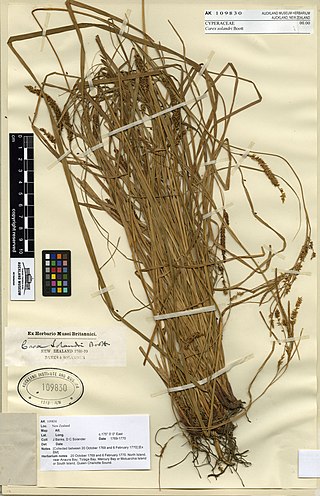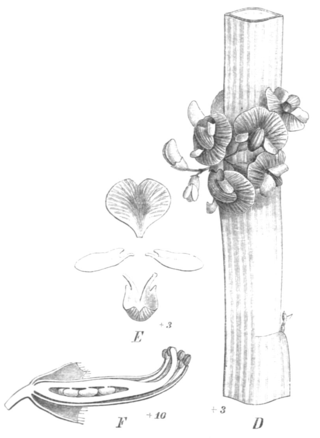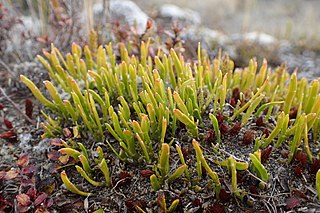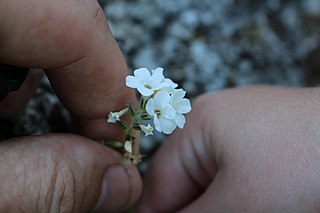
Carmichaelia is a genus of 24 plant species belonging to Fabaceae, the legume family. All but one species are native to New Zealand; the exception, Carmichaelia exsul, is native to Lord Howe Island and presumably dispersed there from New Zealand.

Carmichaelia glabrescens is a species of plant in the family Fabaceae. It is found only in New Zealand.

Carex solandri is a species of sedge that was first described by Francis Boott in 1853.
The Australasian Virtual Herbarium (AVH) is an online resource that allows access to plant specimen data held by various Australian and New Zealand herbaria. It is part of the Atlas of Living Australia (ALA), and was formed by the amalgamation of Australia's Virtual Herbarium and NZ Virtual Herbarium. As of 12 August 2014, more than five million specimens of the 8 million and upwards specimens available from participating institutions have been databased.

Maireana pyramidata is a species of plant within the genus, Maireana, in the family Amaranthaceae. It is endemic to Australia, and widespread throughout Australia in the inland, where it is found in Victoria, New South Wales, Queensland, the Northern Territory and Western Australia.

Lawrencia squamata is a species of plant in the mallow family, Malvaceae. It is endemic to Australia and occurs in all Australian states.

Boronia lanuginosa is a plant in the citrus family Rutaceae and is endemic to northern Australia. It is a shrub with woolly pinnate leaves.

Scaevola canescens is a species of plant in the family Goodeniaceae. It is endemic to Western Australia where it occurs "from Shark Bay to Perth, in open forest and heath in sandy soil".

Atriplex hollowayi, also known as Holloway's crystalwort, is a species of annual herbaceous plant in the genus Atriplex. This species is endemic to New Zealand. It has the "Nationally Critical" conservation status under the New Zealand Threat Classification System.

Carmichaelia astonii is a species of pea in the family Fabaceae. It is found only in South Island of New Zealand. Its conservation status (2018) is "Nationally vulnerable" under the New Zealand Threat Classification System.

Carmichaelia appressa is a species of pea in the family Fabaceae. It is found only in the South Island of New Zealand. Its conservation status (2018) is "At Risk - Naturally Uncommon" under the New Zealand Threat Classification System.
George Simpson (1880–1952) was a New Zealand naturalist and botanist. He was born in Dunedin, the son of a master builder. He, too, became a builder and valuer, working as Crown Valuer from about 1943 until early 1950. However, he, together with John Scott Simpson, became interested in collecting and growing New Zealand native plants and by 1925 both were well known within the New Zealand botanical community.

Carmichaelia australis, commonly known as the New Zealand common broom or mākaka, is a shrub of the Fabaceae family. It is native to New Zealand and found in both the North and South Islands.

Carmichaelia williamsii is a species of plant in the family Fabaceae. It is found only in the North Island of New Zealand. Its conservation status (2018) is "At Risk (relict)" under the New Zealand Threat Classification System.

Carmichaelia nana is a species of plant in the family Fabaceae. It is found in both the North and South Islands of New Zealand. Its conservation status in 2013 was assessed as "At Risk (declinining)" under the New Zealand Threat Classification System, but in 2018 its risk under the same system became "Threatened-Nationally Vulnerable".

Carmichaelia corrugata is a species of plant in the family Fabaceae. It is found only on the South Island of New Zealand.

Coprosma cuneata, is a shrub in the Rubiaceae family, native to New Zealand.

Myosotis glauca is a species of flowering plant in the family Boraginaceae, endemic to the South Island of New Zealand. George Simpson and J.S. Thomson described M. pygmaea var. glauca in 1942, and Peter de Lange and John Barkla recognized it at species rank in 2010. Plants of this species of forget-me-not are perennial with a prostrate habit, bracteate inflorescences, white corollas, and often glaucous grey leaves.

Myosotis brevis is a species of flowering plant in the family Boraginaceae, endemic to New Zealand. George Simpson and J.S. Thomson described M. pygmaea var. minutiflora in 1942, and Peter de Lange and John Barkla recognized it at species rank in 2010, as M. brevis. Plants of this species of forget-me-not are small and annual, with a prostrate habit, bracteate inflorescences, tiny white corollas, and brown or green leaves.

Myosotis lytteltonensis is a species of flowering plant in the family Boraginaceae and a synonym of Myosotis australis. It was first described as a variety of M. australis, considered endemic to the South Island of New Zealand, then raised to species status, and subsequently synonymised with Myosotis australis in 2020. Plants of this species of forget-me-not are perennial rosettes with ebracteate inflorescences and white or yellow corollas with stamens that are fully included in the corolla tube or sometimes partly exserted.




















